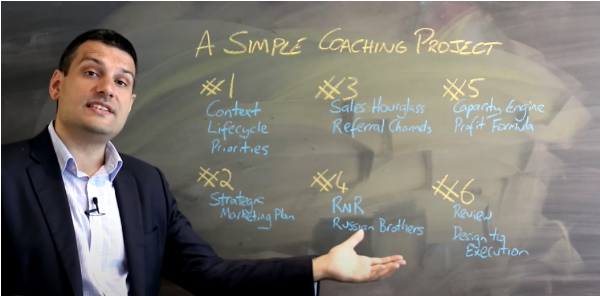Building a B2B Subscription Business. In Blackboard Fridays Episode 26, Jacob talks about Growth Planning. Need this implemented into your business? Talk to the international business advisor who can do exactly that – Contact Jacob, Learn More, or Subscribe for Updates.
Most professional services or other business-to-business (B2B) companies are ‘lumpy’ – some months are super busy and revenue is high; but often the next month is quieter and your team fail to meet their targets.
Whether this is seasonal (accountants are busy in tax planning season), cyclical (architects are a lead indicator of the construction market’s health), or just the nature of your business (clients call lawyers when they need them, or shortly thereafter), you know there has to be a better way.
Every business has the potential to be a subscription business, in one form or another. Maybe for you this is ‘just’ an additional product you can provide to your clients, or a new segment of the market? Perhaps you want to tear down the entirety of your existing, lumpy, unpredictable business and replace it with a steady stream of work and revenue where the only lumps are profitable cream on top?
Either is an exciting opportunity for you. Today’s video starts the conversation about how you can build a B2B Subscription Business. If you want to advance the conversation, let’s chat.
Who is Jacob Aldridge, Business Coach?
“The smart and quirky advisor who gets sh!t done in business.” Back independent since 2019.
Since April 2006, I’ve been an international business advisor providing bespoke solutions for privately-owned businesses with 12-96 employees.
At this stage you have proven your business model, but you’re struggling to turn aspirations into day-to-day reality. You are still responsible for all 28 areas of your business, but you don’t have the time or budget to hire 28 different experts.
You need 1 person you can trust who can show you how everything in your business is connected, and which areas to prioritise first.
That’s me.
Learn more here. Or Let’s chat.
Transcript
Good day, Jacob from businessDEPOT here talking this week about building a subscription business model even if you’re in a professional service of b2b environment. It’s no longer sufficient for us to find ways to build clients for life.
We need to find ways to build paying clients for life. The opportunity for us to deliver value to our client base on a regular and consistent basis in exchange for a regular and consistent income stream.
This blue line represents most professional services businesses and the revenue models that they generate from a client relationship. This applies to lawyers, IT companies, accountants, advisors, even business coaches.
It’s lumpy, it’s unpredictable, and the pain, you’re probably familiar with it, is real. You’re never quite sure when that client, when that project, when that revenue is going to come in. A big project that you’ve been preparing for gets bumped by a month or bumped by a quarter.
Your business goes through ups and downs, peaks and troughs, capacity stress when everybody’s overworked because three clients have come on at once and a whole period of waste where people are inefficient, twiddling their thumbs because projects all finished at the same time or didn’t come off when you are expecting them.
That frustration, that inconsistency, is also a pain for your clients. Nobody likes having big lumpy expenses in their life or in their business.
Your clients are wanting you to find a way to deliver them value on an ongoing basis that’s much more bite-sized, much easier for them to manage regarding their cash flow. So, how do you do it? How do you shift to this new revenue model where you’ve got regular consistent income with perhaps the occasional spiked specific project or additional value that you can deliver?
The process I’ve gone through with several clients who have looked to change their business model is this. First, you need to be able to calculate the capacity engine of your business today and determine from that model whether you’re running at a high capacity, putting a lot of power out of your engine, or whether there’s a lot of and waste. If that’s speaking gibberish to you, go back and watch the earlier blackboard Friday’s video on why growth is the most dangerous word in business.
Once you’ve got a model of your business, all the little parts that make up the engine that drives you, you need to stress test them with some ideas around this new model. Now, exactly what your ongoing subscription model might look like is going to differ depending on your industry and your business and your client base, but you want to take key elements like time and cost to your business and to your clients and stress test them against the capacity model that you’ve built. This will give you an idea as to what is a realistic and feasible ongoing subscription model that you can deliver to your clients.
Once you’ve got an idea of that, you need to wrap that up in some of your marketing language and connect it with your brand promise, your buyer personas, and most importantly go out and have a conversation.
If you watched last week’s episode about how to validate your startup idea, it applies in this situation as well. Go and interview ten of your clients—not the 10 best clients, not the ten worst clients but a good cross-section of your target client base and get their feedback as to whether this model that you started to design is going to add value in their life. If it does then fantastic you’ve now got an opportunity to launch a subscription business model.
I’d encourage most businesses that I work with to launch it over time rather than all at once. You don’t want to overwhelm your clients experience by having all of them going through the new process at the same time. Any mistakes that you make as a business will be exacerbated. Much better to start with better clients and slowly roll it out to the whole client base so that they all get a seamless experience.
The best thing about this is even if your new model is designed to deliver just the same amount of revenue as the old one, by having this consistency, you and the team will be much better placed to find new ways, new opportunities, new revenue streams for your client moving forward and that’s growth and its growth that even as dangerous.
Next Steps
Want to learn more about how this can apply to your business? It costs nothing to chat:
- Email me jacob@jacobaldridge.com (I read them all)
- Call, Text, or WhatsApp me +61 427 151 181
- Or just Subscribe https://jacobaldridge.com/about/subscribe-to-jacob-aldridge-com/ to stay in touch




